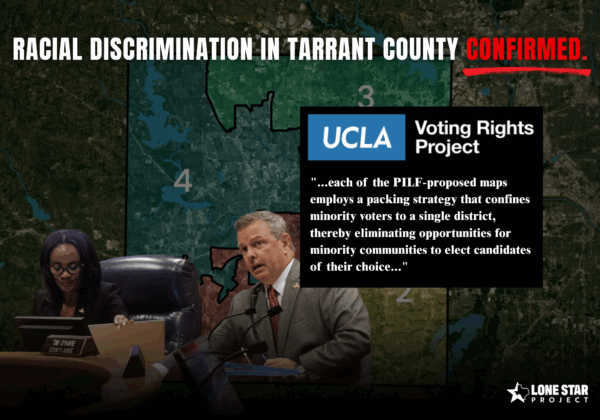Here is a review of some of the actions taken by GOP map-drawers that were cited as evidence for the Court’s ruling that Texas leaders intentionally discriminated against African American and Latino Texans.
1. Targeting and harming the districts of minority Members.
Republican leaders removed key public service resources and “economic engines” from minority congressional districts which the Court ruled was motivated by discriminatory intent. These include removing the district offices from within the boundaries of all three African American Congressional districts and one Latino district (CD’s 9, 18, 20 & 30), removing the Medical Center, Astrodome and Houston Baptist University form Congressman Al Green’s District 9, removing American Airlines Center, the arts district and her home from Congresswoman Eddie Bernice Johnson’s District 30 and removing the Alamo and the Henry B. Gonzalez Convention Center from Congressman Charlie Gonzalez’s District 20. The Court specifically stated:
- “No such surgery was performed on the districts of Anglo Incumbents.” (Page 40)
2. The harm to minority districts was intentional.
The Court did not believe the state’s argument that changes to harmful changes to minority districts were simply a coincidence and unintentional. The Court said:
- “We are confident that the map drawers can not only draw maps but read them, and the locations of these district offices were not secret. The improbability of these events alone could well qualify as a ‘clear pattern, unexplainable on the grounds other than race’ (Arlington Heights, 429 U.S. at 266), and lead us to infer a discriminatory purpose behind the Congressional Plan.” (page 41)
3. Texas has a long and sad history of racial discrimination.
Texas has been involved in litigation in every redistricting cycle since the Voting Rights Act was enacted in 1965- and been found in violation nearly every time. The Court stated,
- “While a losing streak alone does not control our decision, Texas’s history of failures to comply with the VRA is one of the circumstantial factors that Arlington Heights instructs us to consider.” (Page 41)
- “The second factor is Texas’s history of discrimination, and as we discussed in our analysis of the Congressional Plan above, history is not on Texas’s side.” (Page 47)
4. Minority elected officials were shut out.
The Court points to members of Congress representing minority districts and other minority leaders being shut out of the redistricting process.
- “Black and Hispanic members of Congress testified at trial that they were excluded completely from the process of drafting new maps, while the preferences of Anglo members were frequently solicited and honored.” (page 41)
- “Minority members of the Texas legislature also raised concerns regarding the exclusion from the drafting process and the inability to influence the plan via amendments.” (page 42)
- “…every senator who represented an ability district was excluded from this informal map-drawing process and was not allowed into the anteroom to preview maps.” (Page 47)
- “In any case, it is clear that senators who represent minority districts were left out of the process.” (Page 48)
- “We find it telling that the legislature deviated from typical redistricting procedures and excluded minority voices from the process even as minority senators protested that section 5 was being run roughshod.” (page 50 & 51)
5. Targeting Black and Latino voters in Wendy Davis’ Senate District 10
Republicans specifically carved out large African American and Latino neighborhoods in Senate District 10 and attached them to Anglo Republican-controlled districts.
The court said:
- “…there is little question that dismantling SD10 had disparate impact on racial minority groups in the district. Even Dr. Alford [State’s expert witness] agreed that the enacted plan ‘diminishes the voting strengths of Blacks and Latinos …’”. (Page 46)
6. Texas GOP attempted to hide discrimination as partisanship
Republicans said they were only trying to defeat a Democrat and elect a Republican. The Court didn’t buy it.
The Court said:
- “Texas does not deny this disparate impact, but responds that its decision to ‘crack’ SD10 is best explained by partisan, not racial goals. Tex. Post-Trial Br. 25. While this is a potentially plausible rationale, Arlington Heights instructs that ‘determining whether invidious discriminatory purpose was a motivating factor demands a sensitive inquiry into such circumstantial and direct evidence of intent as may be available,’ so we must ‘look to the other evidence.’ 429 U.S. at 266.
- “These other factors do not support Texas’ case.” (Pages 46 & 47)
7. “No Bueno” Memo
The fact that the discriminatory maps were pre-cooked and legislative consideration was only a formality was confirmed by a memo from State lawyer David Hanna warning against drafting the redistricting committee report BEFORE the bill had been considered by the committee. In his email response to the proposal to pre-draft the report, Hanna responded “No Bueno”. The Court said:
- “Although the chairman of the redistricting committee, Kel Seliger, denied knowing of any advance decision to refuse to consider amendments, he acknowledged what is apparent from the email: the boundaries of the new Senate districts would be a fait accompli by the time of the markup and the committee did not intend to consider any amendments to the plan.” (Pages 48 & 49)
8. Republicans failed to counter charges of discrimination
Texas Republicans arrogantly failed to respond to evidence of intentional discrimination. The Court said:
- “That Texas did not, and now fails to respond sufficiently to the parties’ evidence of discriminatory intent, compels us to conclude that the Senate Plan was enacted with discriminatory purpose as to SD10.” (Page 51)
- “… we are also persuad ed by the totality of the evidence that the plan was enacted with discriminatory intent.” (page 42)


